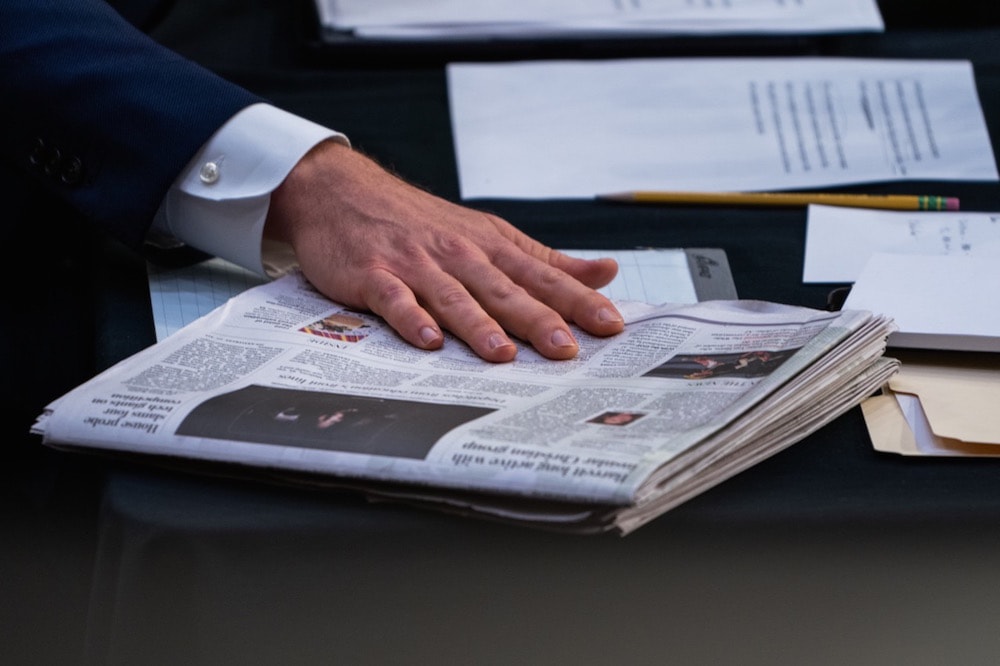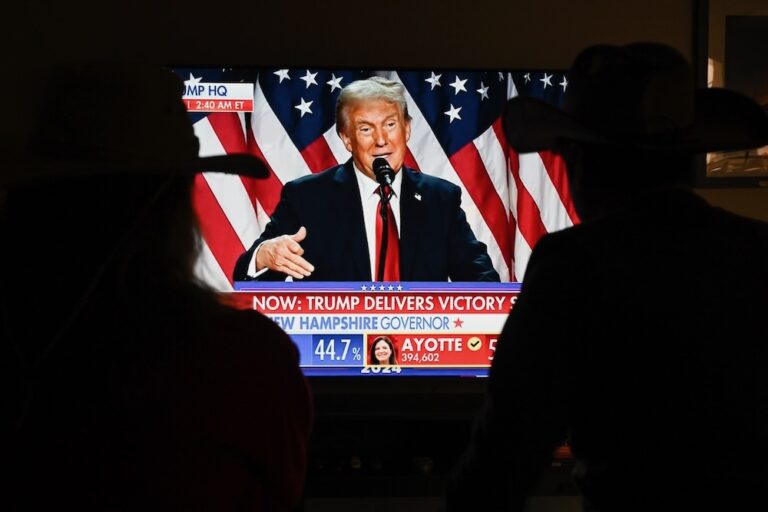'I urge us all to stay steadfast to our traditional distaste for government regulation of journalistic practice. Good journalism is certainly an ideal. It is an admirable quality to urge any media outlet to adopt and follow," EFF Civil Liberties Director David Greene.
This statement was originally published on eff.org on 29 January 2021.
EFF Civil Liberties Director David Greene delivered the following as a keynote address on March 6, 2020, at the Media Law and Policy in the Digital Age: Global Challenges and Opportunities symposium hosted by Indiana University’s Center for International Media Law and Policy Studies and its Barbara Restle Press Law Project.
A few years ago, I was summoned to the office of an eminent TV journalist, one of those people commonly described as “the dean of . . . ” something. He wanted me to come by, he said, because “he had an idea to run by me.” So I went.
After the small talk – we both had suffered the same back injury! – he ran his idea by me. This is a paraphrase: “We should bring back the Fairness Doctrine. And not just for broadcast news, but for all media, especially the Internet. Looking back, I think it made us better journalists.” He was planning a conference and wanted this to be a major discussion point. In my memory, my jaw dropped cartoonishly all the way to the floor.
The Fairness Doctrine was a Federal Communications Commission rule that imposed “fair” reporting requirements on radio and television broadcasters. By “broadcasters,” I, and the FCC, mean those entities that have a license to broadcast over a certain over-the-air frequency, as opposed to cable or satellite or now streaming services. It’s the stuff you get for free if you just plug in a TV or radio with an antenna. The Fairness Doctrine had many facets. But the main one required broadcasters to devote time to discussing controversial matters of public interest, and then to air contrasting views as well. In some circumstances this could require the broadcaster to provide reply time to any person. The rule was in effect from 1949 until 1987. I’ll talk more about it a little later.
As I said, I was taken aback by this eminent journalist’s suggestion. I’ve been a First Amendment lawyer for 20+ years and have worked with and on behalf of journalists and news organizations for much of that time. During all that time, without exception, journalists considered the fairness doctrine to be a serious infringement on editorial discretion and freedom of the press in general. How could this person who I knew to be a champion of a free press want to revive it, and apply it to all news media?
So I responded that it was a terrible idea and probably unconstitutional. Needless to say, I was not invited to participate in his conference.
Unfortunately, this was not an aberration. I’ve seen it repeated in different forms ever since: news media advocates calling for regulation that would have until recently been seen as heretical to our established conceptions of a free press.
The cause, of course, is social media and Internet platforms and Big Tech.
But it’s not that the advent and popularity of social media has adjusted our free press priorities. Rather, social media and the Internet in general has changed the business of news reporting. Legacy new media, especially print, are largely suffering financially, especially at the regional and local levels. And when they see certain social media companies – Facebook, Instagram, Twitter, Google, YouTube, Snapchat – thriving, they reach out for ways to fight these intruders. To look for ways to level the playing field.
I completely understand the frustration that motivates this. I also fear a country with diminished or no local or regional reporting. I’ve seen that there is so much less money now to fund public records requests and court access litigation. Indeed, these lawsuits now often fall to nonprofit organizations like EFF. I subscribe to home delivery of two newspapers and a bunch of magazines.
But it’s a huge mistake to let this despair lead us to a path of abandoning or weakening important free press principles and open the door to the regulation of journalism. Especially when, as I will discuss toward the end of this talk, abandoning these principles won’t actually help.
So my job here today is to convince you that the news media, all facets of it, from news gatherers and reporters to those who simply provide platforms for others to publish to those who simply suggest news reading to others, must stick together and remain unified champions of a free press. To do otherwise is far too dangerous, especially in the anti-press climate cultivated by the sitting Executive branch.
The Fairness Doctrine
Over the past few years, I’ve noticed at least three formerly taboo regulatory threats being given some life by those who are otherwise free press champions.
I’ve already mentioned the Fairness Doctrine. So I’ll start there. As I said earlier, the Fairness Doctrine required broadcasters to present contrasting views of any public controversy. The U.S. Supreme Court upheld the rule in 1969 in a case called Red Lion Broadcasting v. FCC, on the basis that the FCC was merely requiring the broadcaster to momentarily and occasionally share the license that the FCC had granted it. The Court stated, though, that it would reconsider that decision if it became clear that the doctrine was restraining speech (that is, that broadcasters were choosing to avoid discussing public controversies rather than being forced to present both sides of them).
Five years later, the Supreme Court made clear that a similar rule could not be imposed on newspapers. In that case, Miami Herald Co v. Tornillo, the Court struck down a Florida right of reply law that required any newspaper that endorsed a candidate in an election to offer all opponents equal and equally prominent space in the newspaper to respond. The Court explained that such an intrusion into the editorial freedom of a newspaper was per se a violation of the First Amendment. And then in 1996, in ACLU v. Reno, the Supreme Court, in a different context, ruled that the Internet would be treated like print media for the purposes of the First Amendment, not broadcast.
The FCC revoked the Fairness Doctrine in 1987 (although it formally remained on the books until 2011) after a few lower courts questioned its continuing validity and amid great unpopularity among Republicans in Congress. There are occasional Congressional or FCC-initiated attempts to bring it back – many blame it for the advent of seemingly partisan news broadcasts like Fox News, even though the rule never applied to cable television – but none have been successful.
To bring back the Fairness Doctrine and then apply it to all media would mark a serious incursion on First Amendment rights.
Enshrining Professional “Ethics Codes” With the Force of Law
I’ve seen a similar flip with respect to professional ethics, specifically news media advocates urging the legal codification of their voluntary industry ethical standards, embodied in the ethical codes created by professional societies like the Society of Professional Journalists and the Radio and Television News Directors Association, and the National Press Photographers, etc. This typically takes the form of calling for conditioning legal protections for online news production, distribution, aggregation, or recommendation services on following these ethical standards. Like, for example, saying that Wikileaks should be subject to the Espionage Act, because it does not follow such practices, while “ethical journalists” must be exempted from it.
These codes have always been very intentionally voluntary guidelines and not law for several good reasons.
First, ethics are inherently flexible principles that don’t easily lend themselves to absolute rules, tend to be fact-intensive in application, and can vary greatly depending on number of legitimate and worthy priorities. They are generally an ill fit for the bright lines we insist on for laws that limit speech.
Second, free press advocates have been rightfully concerned that transforming journalism’s ethical codes to legal standards will only lead to vastly increased legal liability for journalists. This could happen both directly — by the codes be written into laws — and indirectly — by the codes becoming the “standard of care” against which judges would assess negligence. “Negligence,” that is, the failure to act reasonably, is a common basis for tort liability. It is typically assessed with reference to a standard of care, that is, the care a reasonable person would have exercised. Were ethical codes to become the standard of care, journalists could bear legal liability any time they failed to follow an ethical rule, and, even worse, have to defend a lawsuit every time their compliance with an ethics rule was even a question. And they would then be held to a higher standard than non-journalists who would only need to act as a “reasonable person,” instead of as a “professional journalist.”
Third, and perhaps most basically, this would be direct governmental regulation of the press, something antithetical to our free speech principles.
These all remain correct and relevant, and it remains a bad idea to give professional ethical codes the force of law or condition other legal protections on adherence to them.
Expanding Republication Liability
The third flip I’ve seen, and this is probably the most common one, is a sudden embrace of republication liability. Republication liability is the idea that you are legally responsible for all statements that you republish even if you accurately quote the original speaker and attribute the statement to them. To have my students truly understand the implications of this rule, that is, to scare them, I like to discuss two examples.
In one case, Little v. Consolidated Publishing, (Ala App 2010), a reporter attended a city council meeting. Her reporting on the meeting included an accurate quotation of a city council member, Spain, who at the meeting repeated rumors that one of his rival council members, Little, was in a personal relationship with a city contractor and thus pushed for her hiring, a move that was now being questioned. The article included another statement from Spain in which he said that if the rumors about Little were untrue, they would be very unfair to Little. The article also included Little’s denial. Nevertheless, Little sued the newspaper for defamation. The court rejected the argument that the publication was true since the rumor was in fact circulating at the time. The court explained that “publication of libelous matter, although purporting to be spoken by a third person, does not protect the publisher, who is liable for what he publishes,” and that it did not matter if in the same article the newspaper had decried the rumor as false.
In another case, Martin v. Wilson Publishing (RI 1985), a newspaper published an article about a real estate developer buying up historic properties in a small village. The article was generally supportive of the development and investment in the village, but explained that some residents were “less than enthusiastic” about the developer’s plans and “doubted his good intentions.” The article then stated that “some residents stretch available facts when they imagine Mr. Martin is connected with the 1974 rash of fires in the village. Local fire official feel that certain local kids did it for kicks.” And the article further expressed doubts about the claims of arson. The developer sued, and the court found that the newspaper could be liable for this republication even though the rumors did in fact exist and even though the newspaper had reported that it believed they were false.
The republication liability rule apparently dates back to old English common law, the foundation of almost all US tort law. Originally it seems to have been a defense to accurately attribute the statement to the original speaker. But attribution hasn’t helped a reporter since at least 1824, when English courts adopted the present rule, and it quickly was adopted by US courts.
In my twenty or so years of teaching this stuff, republication liability is by far the most counter-intuitive thing I teach. Students commonly refuse to believe it’s true. It leads to absurd results. Countless journalists ignore it and hope they don’t get sued.
And it gets worse, or at least more complicated. Since at least 1837 (the earliest English case I could find), republication liability has been imposed not just on those who utter or put someone else’s libelous words in print, but also to those who are merely conduits for libel reaching the audience. The 1837 case, Day v. Bream, imposed liability on a courier who delivered a box of handbills that allegedly contained libelous statements in them, unless he could prove that he did not know, and should not have known, of the contents of the box. Early cases similarly impose knowledge-based liability on newsstands, libraries, and booksellers. The American version of this knowledge-based “distributor” liability is most commonly associated with the U.S. Supreme Court’s 1959 decision in Smith v. California, which found that a bookseller could not be convicted of peddling obscene material unless it could be proven that the bookseller knew of the obscene contents of the book. Outside of criminal law, US courts imposed liability on distributors who simply should have known that they were distributing actionable content.



